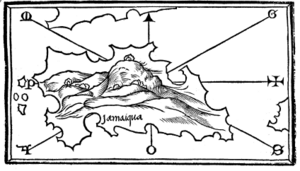Juan de Esquivel facts for kids
Juan de Esquivel (born around 1480, died around 1515) was an important Spanish explorer and the first governor of Jamaica. He played a key role in the early days of Spanish settlement in the Caribbean.
Early Life and Explorations
Juan de Esquivel was born in Seville, Spain. His father was Pedro de Esquivel, and his mother was Constanza Fernandez de Arauz. In 1493, Juan de Esquivel joined Christopher Columbus on his second journey to the West Indies. He settled on the island of Hispaniola, which is now shared by Haiti and the Dominican Republic.
In 1502, the governor of the Indies, Nicolás de Ovando, sent Esquivel with 400 men to establish Spanish control in the eastern part of Hispaniola. This region was home to the Taino people. A young man named Bartolomé de las Casas was with the Spanish group. He later wrote about the difficult times he saw during this period.
Around 1504, Esquivel became a procurador, which means a legal representative, for the towns on Hispaniola. He was sent back to Spain to talk to the king. He asked the king to lower the high taxes on gold mining. He also asked for better rules for trading goods that were brought to the islands. The king agreed to reduce the royal tax on gold from one-third to one-fifth. He also ended the king's full control over trade with the islands.
Governing Jamaica
After Columbus passed away in 1506, his son Diego Colon claimed his right to be the main governor, or viceroy, of the lands his father had found. Colon returned to Hispaniola in 1509. He found that Jamaica had been divided between two Spaniards who were not friendly to his rule. So, he sent Esquivel with seventy men to take control of the island. Pánfilo de Narváez was his second-in-command. Esquivel brought his wife and daughters with him to Jamaica.
The Spanish quickly took control of Jamaica. Esquivel then founded two towns: Sevilla la Nueva on the north coast and Santa Gloria. No gold was found on Jamaica, but the land was very good for farming. The Spanish were told to work with the local people to grow food crops. These crops were then sent to the mainland and other islands. King Ferdinand told Colon to treat the native people of Jamaica well. He wanted them to thrive and not decrease in numbers, as had happened on Hispaniola.
Since there was no gold, the colony was not as rich as people had hoped. In early 1512, some even suggested that the colonists move to Cuba. There, Diego Velázquez de Cuéllar was trying to establish Spanish control. The move never happened. However, Esquivel did send Narváez and thirty crossbowmen to Cuba to help Velázquez.
King Ferdinand was not happy with the way things were going in Jamaica. He knew that Colon spoke highly of Esquivel. But he thought that the lack of gold might be due to some kind of problem. He also felt that Esquivel had not done enough to help the native people or to increase the king's income. He ordered a residencia for Esquivel's time in office. A residencia was a special review or audit of an official's work. This often happened when an official was about to be replaced. The exact timing is not clear, but by November 1514, Esquivel had been replaced by Francisco de Garay.
According to a historian named Bryan Edwards, Juan de Esquivel was known as one of the few Spanish leaders who was generous and kind.
See also
- Colony of Santo Domingo
- Colony of Santiago (Jamaica)
- Spanish West Indies
- In Spanish: Juan de Esquivel para niños


